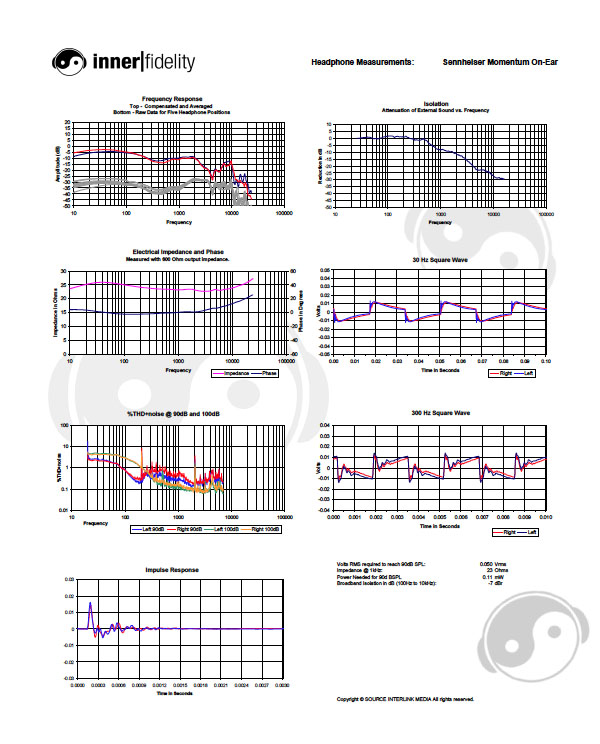| Columns Retired Columns & Blogs |
A Headset for Everyone: The Sennheiser Momentum On-Ear Measurements
Click on graphs image to download .pdf for closer inspection.
Raw frequency response plots show a broad and relatively modest change in FR tilt to about 1kHz as the pad seal changes during repositioning for the five measurements. I think Sennheiser must have done a lot of work with the pad materials and shape to deliver such a gentle and relatively well controlled FR result with various sealings on the ear. For a moment, have a look at the isolation plot and you'll see that he MOE doesn't isolate particularly well. I think what Sennheiser has done is build a pad with a very controlled amount of leakage, and then designed the acoustic performance around it. The advantage is that the bass response is not strongly effected by the seal performance. If you're going to build an on-ear headphone that you know will have problems sealing (as all sealed on-ear headphones do), then why not build one with a controlled leak so it becomes insensitive to the seal? We'll be coming back to this idea quite a few times with the MOE measurements.
The MOE has an overall warm tilt that looks about right to me, but it also has three distinct humps. The broad bass hump to 300Hz is centered around the primary driver resonance, which can be seen in the impedance response topping out at around 40Hz. Let's dwell on the bass here for a moment and look at the THD+noise plots. The MOE suffers from some significant bass distortion, but it's also self-limiting to about 3% at 90dBspl and 5% at 100dBspl. You'll also notice the very nice waveform shape of the 30Hz square wave. This tells me that although the bass is somewhat distorted, it's not going out of phase, which usually makes headphones sound loose in the bass. The bass I heard in listening was a bit thick, but it never lacked punch.
Take all four of these measurements together (FR, Impedance, THD, and 30Hz square wave) and what I see is Sennheiser engineers taking a complex and difficult problem, and making some subtle and elegant compromises. Sure, I'd like to see a tad less bass response and a bit lower distortion, but I think they've made some very wise and balanced choices for consuming public.
Back to the compensated frequency response: After the clear dip at 400Hz relative to the overall warm tilt, the frequency response gently rises to 2Khz. Many cans fall off at 1kHz, and the upper harmonics of the voice tend to be lost a bit. Being flat to 2kHz gives the MOE a nice presence and snap. The dip around 4kHz is common and not much is known about where flat is in the area, but I heard the MOE as clean and refined in the low treble. The 10kHz peak is also common, and I've lately begun to feel that if the 10kHz peak does not exceed the line drawn through the average response on the lower frequencies, then the 10kHz peak will not be heard as excessive, which is the case with the MOE. FR above 10kHz doesn't suffer from much noise, which is pretty cool—you don't see that very often—but seems about 5dB too low overall. The MOE did lack some air in the high treble during listening.
As I mentioned the 30Hz square wave has excellent shape, and the leading edge spike does not exceed the high point of the following wave shape—another indicator to me that these will not sound strident or harsh, which was the case during listening.
300Hz square wave shows a modest initial spike, and then a return to the baseline without too much overshoot or subsequent ringing. Similarly, the impulse response shows a nice clean impulse with some subsequent moderate high frequency ringing, but again, this is a fairly clean impulse response shape for this type of headphone.
I recommend those with an interest in measurements have a look at the V-Moda M80 in comparison to the MOE and relative to my comments above. The bass seal is not as repeatable, and frequency response in the bass varies more. The impedance response is rougher, which usually indicates poorer acoustic control around the driver. The 300Hz square wave is bowed downward more strongly, and bass distortion starts at a higher frequency and climbs slightly higher. Initial transient of the 300Hz square wave and impulse response are good, but are followed by more substantial ringing at a lower frequency. Bottom line: the Momentum On-Ear has more finesse across the board, and you can hear it as a clearer, more refined headphone. The mid-range recession is smaller though, making the M80 a bit truer to the critical mid-range balance.
Back to the MOE, isolation is quite poor on these cans. While that can be problematic in loud environments, it does aid in urban situational awareness.
With 50mVolts and 0.11mW needed to achieve 90dBspl, these cans will be somewhat lower in volume than many of this type when being driven by a smartphone or portable media payer, but will still reach satisfying listening levels.
These are very good measurements for this type of headphone!
- Log in or register to post comments





































